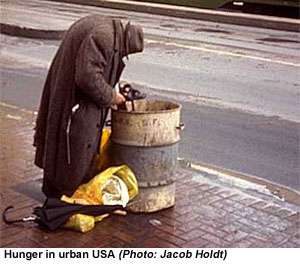
America's poverty crisis is straining the resouces of many US cities

FRONT PAGE
Site Search
About us
 

Poverty in US cities
US urban inequality
Vision for metro America
US cities fight back
US poverty 2011
Non-profits vital to urban USA
US metro 2010
US prison closures - Cities
US metro economies 2011
US socio-economic trends
US abortion debate
2009 homelessnees in US cities
US clergy and local politics
Minorities in the US
US education 2042
US mayors and schools
US public school integration
US military schools
Denver's pre-k programme
Banned books in US schools
Tea Party Patriots
Social services in US schools
Arizona's controversial immigration law
US socio-economic trends
US mayors silent on racial profiling
English-only US cities
Failed US immigration reform
US gun contol in tatters
US cities and illegal immigrants
US migration

Worldwide | Elections | North America | Latin America | Europe | Asia | Africa |


























|
|
Hunger and homelessness remain
most pressing issues for US cities
A report by the US Conference of Mayors
26 December 2012: Despite dwindling resources, US cities are facing an increasing demand to provide emergency food and shelter to poor Americans. In its annual report on hunger and homelessness, the US Conference of Mayors notes that in more than 64 per cent of cities homeless families were being turned away by emergency shelters because no beds were available. And emergency kitchens and food pantries in many cities had to serve smaller meals to clients. In many instances the lack of resources meant people in need had to be turned away.
The Mayor of Louisville, Greg Fischer, said at a press conference that the report was a stark reminder of the long-lasting impact the recession has had on many citizens. “Families, who once lived in middle class homes, now find themselves without a roof over their heads, needing multiple social services for the first time in their lives,” he explained.
The cities, which took part in the poverty research, were pessimistic about the future: Three out of four expect requests for emergency food assistance to increase over the during 2013 and nearly half expect that resources to provide emergency assistance will decrease – some - 22 per cent - say substantially. The combination of increasing demand and decreasing resources was cited most frequently as the biggest challenge they will face in addressing hunger in the coming year. Officials in 60 per cent of the cities expect the number of homeless families to increase over the next year; those in 56 per cent of the cities expect the number of homeless unaccompanied individuals to increase; and those in more than 58 per cent expect that the resources needed to provide emergency shelter will decrease.
 Key findings on hunger Key findings on hunger
• All but four (82 per cent) of the survey cities reported that requests for emergency food assistance increased over the past year; three cities said requests remained at the same level and one said they decreased. Across the survey cities, emergency food assistance requests increased by an average of 22 per cent.
• Among those requesting emergency food assistance, 51 per cent were persons in families, 37 per cent were employed, 17 per cent were elderly, and 8.5 per cent were homeless.
• Unemployment led the list of causes of hunger cited by the survey cities, followed by poverty, and low wages and high housing costs (both of which were cited by the same number of cities).
• The cities reported an average increase of just 0.2 per cent in the number of pounds of food distributed during the past year. Fifty-eight per cent of the cities saw an increase in the number of pounds of food distributed; 42 per cent reported a decrease.
• Across the responding cities, budgets for emergency food purchases increased by 11 per cent. Fifty-seven per cent of the cities reported that their total budget for emergency food purchases increased over the past year; one-third said it decreased; two cities said it remained the same. Collectively, in the survey cities, the year’s total emergency food budget was $251 million.
• Across the survey cities, 19 per cent of the people needing emergency food assistance did not receive it.
• In 95 per cent of the survey cities, emergency kitchens and food pantries had to reduce the quantity of food persons can receive at each food pantry visit or the amount of food offered per meal at emergency kitchens. In 89 per cent of the cities these facilities had to turn people away because of lack of resources. In 81 per cent of the cities they had to reduce the number of times a person or family can visit a food pantry each month.
• Providing more affordable housing and more jobs led the city officials’ list of actions needed to reduce hunger, with 71 per cent of the cities calling for both. They were followed by providing more employment training programs and increasing food stamp benefits, also with half of the cities calling for both.
• Three-fourths of the survey cities expect requests for emergency food assistance to increase over the next year, with 16 cities expecting the increase to be moderate and two expecting it to be substantial. One-fourth of the cities expect requests to continue at about the same level. No cities expect a decrease in requests.
• Nearly half of the cities (48 per cent) expect that resources to provide emergency food assistance will decrease over the next year, with 26 per cent of the cities expecting that decrease to be moderate and 22 per cent expecting it to be substantial. Thirty per cent expect resources to continue at about the same level. Twenty-two per cent of the cities expect a moderate increase in resources.
• The combination of increasing demand and decreasing resources was cited most frequently by survey city officials as the biggest challenge they will face in addressing hunger in the coming year. Among their concerns are cuts in federal commodities and funding, declining food donations, and the negative impact of the nation’s continuing economic problems on their ability to meet food assistance needs.
Key findings on homelessness
• Over the past year, the total number of persons experiencing homelessness increased across the survey cities by an average of seven per cent, with 60 per cent of the cities reporting an increase. Twelve per cent of the cities said the number stayed the same; 28 per cent said it decreased.
• The number of families experiencing homelessness increased across the survey cities by an average of eight per cent, with 71 per cent of the cities reporting an increase, 12.5 per cent saying the number stayed the same, and 17 per cent reporting a decrease.
• The number of unaccompanied individuals experiencing homelessness over the past year increased across the survey cities by an average of five per cent, with 35 per cent reporting an increase and 26 per cent saying it stayed the same. Thirty-nine per cent reported a decrease.
• City officials cited the lack of affordable housing as the leading cause of homelessness among families with children. This was followed by poverty, unemployment, eviction, and domestic violence. Lack of affordable housing also led the list of causes of homelessness among unaccompanied individuals, followed by unemployment, poverty, mental illness and the lack of needed services, and substance abuse and the lack of needed services.
• The survey cities reported that, on average, 30 per cent of homeless adults were severely mentally ill, 18 per cent were physically disabled, 17 per cent were employed, 16 per cent were victims of domestic violence, 13 per cent were veterans, and four per cent were HIV Positive.
• Across the survey cities over the past year, an average of 17 per cent of homeless persons needing assistance did not receive it. Because no beds are available for them, emergency shelters in 64 per cent of the survey cities must turn away homeless families with children; shelters in 60 per cent of the cities must turn away unaccompanied individuals.
• Fifty-two per cent of the survey cities have adopted policies and/or implemented programs aimed at preventing homelessness among households that have lost, or may lose, their homes to foreclosure.
• Providing more mainstream assisted housing led the list of actions needed to reduce homelessness in the survey cities. This was followed by providing more permanent supportive housing for people with disabilities, and having more or better-paying employment opportunities.
• Officials in 60 per cent of the survey cities expect the number of homeless families to increase over the next year, with one city expecting the increase to be substantial and the rest expecting it to be moderate. Twenty-eight per cent expect the number will remain at about the same level; 12 per cent expect a moderate decrease.
• Officials in 56 per cent of the cities expect the number of homeless unaccompanied individuals to increase over the next year, with two of these cities expecting a substantial increase and the rest expecting a moderate increase. Nearly one-third (32 per cent) expect the number will remain at about the same level. A moderate decrease is expected in 12 per cent of the cities.
• Officials in 58.5 per cent of the cities expect resources to provide emergency shelter to decrease over the next year, with 46 per cent expecting a moderate decrease and 12.5 per cent expecting a substantial decrease. Twenty-nine per cent of the cities expect resources to continue at about the same level; 12.5 per cent of the cities expect a moderate increase.
|
|

|


































 Key findings on hunger
Key findings on hunger